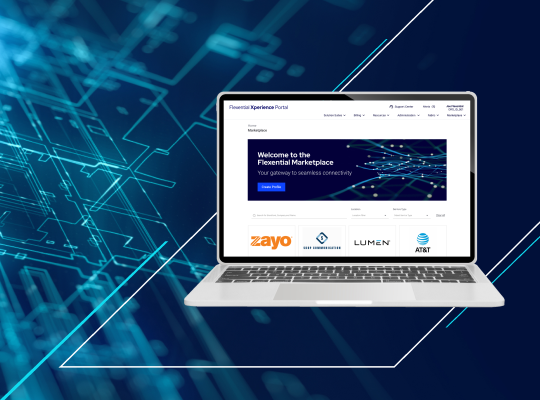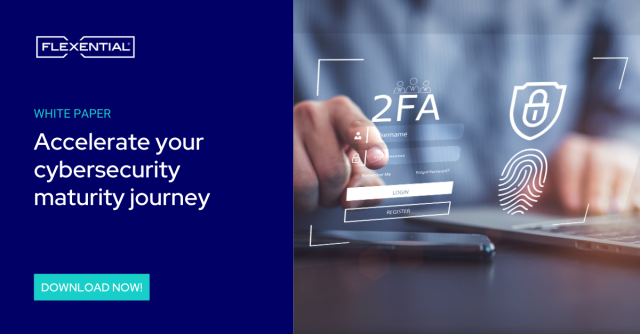From AI to data privacy: Key trends shaping cybersecurity
Cybersecurity continues to be a critical concern for businesses, especially with the rapid advancement of technology and increasing sophistication of cyber threats.

In a recent interview with Will Bass, VP of Cybersecurity Services at Flexential, several key trends that are shaping the data protection and security landscape emerged. This blog will explore these trends, offering insights and practical advice for IT buyers looking to enhance their cybersecurity strategies.
Trend #1: The role of AI in cybersecurity
Artificial Intelligence (AI) is transforming cybersecurity in numerous ways. According to Bass, AI can significantly enhance the capabilities of junior cybersecurity personnel, enabling them to perform tasks typically reserved for more experienced professionals. AI-powered tools can filter out noise in Security Operations Centers (SOCs), allowing analysts to focus on actionable threats.
Key benefits of AI in cybersecurity:
- Noise reduction: AI can sift through vast amounts of data to identify real threats.
- Learning and adaptation: AI systems can learn from actions taken on threats and improve over time.
- Efficiency: Junior analysts can leverage AI to quickly find answers to cybersecurity problems, like seasoned IT professionals used Google back when they were junior team members.
However, while AI offers substantial advantages, it also introduces new challenges and threats that organizations must be prepared to address.
Challenges and threats of AI in cybersecurity:
- AI misuse by bad actors: Hackers and cybercriminals increasingly use AI to enhance their attacks. For example, AI can craft more convincing phishing emails and social engineering attacks. These AI-generated communications can deceive even the most vigilant employees, leading to security breaches.
- Cost and accessibility: Implementing AI solutions can be expensive, and while larger organizations may afford these tools, smaller businesses might struggle with the costs. Additionally, as AI technology becomes more accessible, the barrier for hackers to use AI in their attacks will lower, increasing the prevalence of AI-powered cyber threats.
- Complexity and implementation: Integrating AI into existing cybersecurity programs can be complex and requires specialized knowledge. Organizations must adequately train their teams to manage and optimize AI systems to avoid potential vulnerabilities.
By understanding and addressing the challenges associated with AI, organizations can leverage this powerful technology to enhance their cybersecurity posture while protecting against potential risks.
Trend #2: The importance of data privacy
Data privacy remains a top priority, especially with AI's expanding scope. Bass highlights the necessity for robust internal processes to ensure that sensitive data, such as Personally Identifiable Information (PII) and Protected Health Information (PHI), do not end up in public AI models. This concern is exacerbated by varying state privacy laws and the need for comprehensive federal legislation.
Key considerations for data privacy:
- Internal policies: Develop and enforce stringent data handling policies to prevent sensitive information from being exposed to public AI models.
- Compliance with privacy laws: With nearly 20 states having their own privacy laws, and more on the way, organizations must navigate a complex legal landscape. Adapting to these diverse regulations is crucial for maintaining compliance and protecting user data.
- Advocacy for federal legislation: A unified federal privacy law would simplify compliance and enhance data protection nationwide. Bass expresses hope that increasing concerns around AI and data privacy might push federal legislation forward in the near future.
Challenges in data privacy:
- Data mismanagement: Inadequate internal policies can lead to unintentional exposure of sensitive data, increasing the risk of breaches.
- Legal complexity: The patchwork of state privacy laws creates a challenging environment for organizations to ensure compliance across different jurisdictions.
- AI and data handling: As AI becomes more integrated into business processes, ensuring that AI systems handle data ethically and legally adds another layer of complexity.
Trend #3: Effective data classification
Data classification is crucial for determining what information can be fed into AI models and how it can be consumed. Bass notes that many organizations need help properly classifying their data, which is essential for maintaining security and privacy.
Importance of data classification:
- Risk management: Proper classification helps identify the most sensitive data, enabling organizations to prioritize its protection.
- Regulatory compliance: Ensures that data handling complies with legal requirements, reducing the risk of penalties.
- Operational efficiency: Streamlines data management processes, making it easier to apply appropriate security measures.
Challenges in data classification:
- Complexity: Establishing clear classification criteria can be difficult with diverse data types and usage scenarios.
- Consistency: Ensuring uniform application of classification policies across the organization requires continuous monitoring and training.
- Integration with AI: Deciding what data can be safely used in AI models without compromising privacy or security is complex.
Tips for data classification:
- Identify critical data: Classify data based on sensitivity, such as internal secrets, PII, PHI, and public marketing data.
- Develop clear policies: Establish guidelines for what data can be shared internally, with partners, and publicly.
- Monitor and update regularly: Review and update data classification policies to adapt to new threats and regulations.
Trend #4: The evolving threat of ransomware
Ransomware remains a significant threat, with a noticeable shift towards extortion-based tactics. Bass explains that while many organizations have improved their defenses and recovery capabilities, attackers now focus on exfiltrating data and threatening to release it if ransoms are not paid.
Current ransomware trends:
- Extortion-based tactics: Attackers are increasingly exfiltrating data and threatening to release it unless a ransom is paid.
- Improved defenses: Organizations are getting better at defending against ransomware due to stricter cyber insurance requirements and better recovery practices.
- Sector-specific vulnerabilities: Healthcare and local governments remain particularly vulnerable due to their critical services and often limited cybersecurity budgets.
Strategies to combat ransomware:
- Enhance cyber defenses: Strengthen security measures and regularly test defenses to help counter ransomware threats.
- Implement cyber insurance: Ensure comprehensive cyber insurance policies meet evolving requirements.
- Educate employees: Conduct regular training to prevent common entry points, such as phishing emails or other types of social engineering.
Challenges in combating ransomware:
- Adaptability of attackers: Cybercriminals constantly evolve their tactics, requiring organizations to stay ahead with the latest defense strategies.
- Human error: Many ransomware attacks begin with an employee mistake, highlighting the need for ongoing education and vigilance.
- Recovery complexity: Even with solid defenses, recovering from a ransomware attack can be time-consuming and costly.
Trend #5: Rise of the Chief Information Security Officer (CISO)
Bass observes a growing trend of small to mid-sized organizations prioritizing security by hiring CISOs instead of CIOs, with IT functions reporting to the CISO. This shift reflects the increasing importance of cybersecurity in overall business strategy.
Benefits of a CISO-centric approach:
- Focused security leadership: A CISO provides dedicated oversight for cybersecurity initiatives.
- Integrated security strategy: Combining IT and security functions under one leader ensures a cohesive approach.
- Enhanced risk management: A CISO can more effectively manage and mitigate security risks.
Challenges of a CISO-centric approach:
- Resource allocation: Smaller organizations might struggle to allocate sufficient resources for both IT and security under one role.
- Balancing responsibilities: Ensuring the CISO can effectively manage IT operations and cybersecurity without being overwhelmed.
- Evolving threat landscape: The CISO must stay updated on the latest threats and trends to protect the organization effectively.
Trend #6: DevSecOps and “shifting left”
The integration of security into the development process, known as DevSecOps, is becoming increasingly important. Bass explains that “shifting security left,” or incorporating it early in the development lifecycle, can significantly reduce costs and enhance security.
Benefits of DevSecOps:
- Early detection of issues: Identifying and addressing security vulnerabilities early in development is more cost-effective and less disruptive.
- Improved collaboration: Integrating security into DevOps fosters collaboration between development and security teams.
- Enhanced security posture: Continuous security testing and monitoring throughout the development cycle leads to more secure applications.
Challenges of DevSecOps:
- Cultural shift: Transitioning to a DevSecOps model requires a cultural change within the organization, promoting collaboration and shared responsibility for security.
- Resource allocation: Ensuring that security teams have the necessary resources to participate effectively in the development process.
- Tool integration: Implementing the right tools and processes to support security in the development pipeline.
Steps to implement DevSecOps:
- Invest in training: Educate development and security teams on the principles of DevSecOps and the importance of early security integration.
- Adopt the right tools: Implement tools that facilitate continuous security testing and monitoring throughout the development process.
- Foster a collaborative culture: Promote a culture of collaboration and shared responsibility for security within the organization.
Conclusion
The cybersecurity landscape is rapidly evolving, with new technologies and threats emerging regularly. Organizations can stay ahead of these challenges by leveraging AI, enhancing data privacy, effectively classifying data, combating ransomware, prioritizing security leadership, and integrating security into development processes. As Will Bass's insights demonstrate, proactive measures and a comprehensive approach to cybersecurity are essential for protecting sensitive data and maintaining business continuity in today's digital age.
For IT leaders seeking data protection services, understanding these trends and implementing the recommended strategies will be crucial in safeguarding their organizations against evolving cyber threats.
Ready to accelerate your cybersecurity maturity journey? Explore the ever-evolving landscape of cybersecurity and uncover actionable steps to accelerate your organization's cybersecurity maturity, reduce risks, and fortify defenses efficiently with our comprehensive guide to understanding and advancing cybersecurity maturity.







